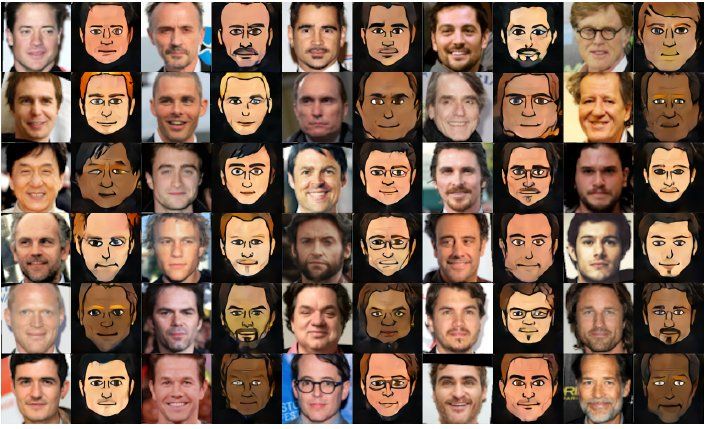DTN : Image Translation with GAN (3)

2. Unsupervised Cross-Domain Image Generation (DTN)
published to ICLR2017 by Yaniv Taigman, Adam Polyak, Lior Wolf
Learn $ G: S \rightarrow T $ of two related domains, $ S $ and $ T $ without labels! (labels of images are usually expensive)



Baseline model

$ D $ : discriminator, $ G $ : generator,
$ f $ : context encoder. outputs feature. (128-dim)
\begin{equation}
R_{GAN} = \max_D \mathbb{E}_{x\sim\mathcal{D}_S} \log[1-D(G(x))] + \mathbb{E}_{x\sim\mathcal{D}_T} \log[D(x)]
\end{equation}
\begin{equation}
R_{CONST} = \mathbb{E}_{x\sim\mathcal{D}_S} d(f(x),f(G(x)))
\end{equation}
$f$-constancy : Does $x, G(x)$ have similar context?
$ d $ : distance metric. ex) MSE
$ f $ : "Pretrained" context encoder. Parameter fixed.
$f$ can be pretrained with classification task on $S$
Minimize two Risks : $ R_{GAN}$ and $ R_{CONST} $
Experimentally, Baseline model didn't produce desirable results.
Thus, similar but more elaborate architecture proposed
Proposed "Domain Transfer Network (DTN)"

First, $ f $ : the context encoder now encode as $f(x)$ then $g$ will generate from it : $ G = g(f(x)) $
$g$ focuses to generate from given context $f(x)$
Second, for $x \in \mathbf{t}$, $x$ is also encoded by $f$ and applied $g$
"Pretrained $f$ on $S$" would not be good as much as on $T$. But enough for context encoding purpose
$ L_{TID}$ : $G(x)$ should be similar to $x$
Also $D$ takes $G(x)$ and performs ternary (3-class) classification. (one real, two fakes)
Losses
Discriminator loss : $L_D$
\begin{equation}
L_D = -\mathbb{E}_{x \in \mathbf{s}} \log D_1 (G(x)) - \mathbb{E}_{x \in \mathbf{t}} \log D_2 (G(x)) - \mathbb{E}_{x \in \mathbf{t}} \log D_3 (x)
\end{equation}
$D_i(x): Probability$
$D_1(x)$ : generated from $S$? / $D_2(x)$ : generated from $T$? / $D_3(x)$ : sample from $T$?
Generator : Adversarial Loss $L_{GANG}$
\begin{equation}
L_{GANG} = - \mathbb{E}_{x \in \mathbf{s}} \log D_3 (G(x)) - \mathbb{E}_{x \in \mathbf{t}} \log D_3(G(x))
\end{equation}
Fool $D$ to classify as sample from $T$
Generator : $L_{CONST}$ and Identity preserving $ L_{TID}$
\begin{equation}
L_{CONST} = \sum_{x \in \mathbf{s}} d(f(x),f(g(f(x)))
\end{equation}
, in feature level
\begin{equation}
L_{TID} = \sum_{x \in \mathbf{t}} d_2(x,G(x))
\end{equation}
, in pixel level
$d, d_2$ used as MSE in this work
\begin{equation}
L_{G} = L_{GANG} + \alpha L_{CONST}+ \beta L_{TID} + \gamma L_{TV}
\end{equation}
$L_{TV}$ is for output smoothing.
$L_G$ minimized over $g$
$L_D$ minimized over $D$
Experiments
- Street View House Numbers (SVHN) $\rightarrow$ MNIST
- Face $\rightarrow$ Emoji
Both cases, $S$ and $T$ domains differ considerably
SVHN $\rightarrow$ MNIST
Pretrain $f$ on $SVHN_{f_TRAIN}$
Learn $G: SVHN_{DTN_TRAIN} \rightarrow MNIST_{TEST}$
Train a MNIST classifier on $MNIST_{TRAIN}$. will be used as evaluation purpose later
Domain transfer on $SVHN_{TEST}$ : $G(SVHN_{TEST})$

$f$
- 4 convs (each filters 64,128,256,128) / max pooling / ReLU
- input $32 \times 32$ RGB / output 128-dim vector.
- $f$ do not need to be very powerful classifier.
- achieves 4.95% error on SVHN test set
- Weaker in $T$ : 23.92% error on MNIST.
- Learn analogy of unlabeled examples
$g$
- Inspired by DCGAN
- SVHN-trained $f$'s 128D representation $\rightarrow 32\times32$
- four blocks of deconv, BN, ReLU. TanH at final.
- $$ L_{G} = L_{GANG} + \alpha L_{CONST}+ \beta L_{TID} + \gamma L_{TV} $$
$\alpha=\beta=15, \gamma=0$


Evaluate DTN
Train classifier on $MNIST_{TRAIN}$.
Architecture same as $f$
MNIST performance 99.4% test set.
Evaluate by testing MNIST classifier on $ G(\mathbf{s}_{TEST}) = { G(x)|x \in \mathbf{s}_{TEST} } $ using $Y$ : $\mathbf{s}_{TEST}$ label.


Experiments: Unseen Digits
Study the ability of DTN to overcome omission of a class in samples.
For example, class '3' Ablation applied on
- training DTN, domain $S$
- training DTN, domain $T$
- training $f$.
But '3' exists in testing DTN! Compare results.







(a) The input images. (b) Results of our DTN. (c) 3 was not in SVNH. (d) 3 was not in MNIST. (e) 3 was not shown in both SVHN and MNIST. (f) The digit 3 was not shown in SVHN, MNIST and during the training of f.

Domain Adaptation
$S$ labeled, $T$ unlabeled, want to train classifier of $T$
Train k-NN classifier


Face $\rightarrow$Emoji
- face from Facescrub/CelebA
- emoji gained from bitmoji.com, not publicized
preprocess on emoji with heuristics. Align face. - $f$ from DeepFace pretrained network. (Taigman et al. 2014) the author's previous work
- $f(x)$ is 256-dim
- $g$ outputs $64 \times 64$
- SR (Dong et al. 2015) to upscale final output.
Results
choose $\alpha=100, \beta=1, \gamma=0.05$ via validation


Original style transfer can't solve it

DTN also can style transfer.
DTN is more general than Styler Transfer method.
Limitations

- $f$ usually can be trained in one domain, thus asymmetric.
- Handle two domains differently.
- $T \rightarrow S$ is bad.
- Bounded by $f$. Needs pre-trained context encoder.
- any better way to learn context without pretraining?
- Any more $S \rightarrow T$ tasks?
Conclusion
- Demonstrate Domain Transfer, as an unsupervised method.
- Can be generalized to various $S \rightarrow T$ problems.
- $f$-constancy to maintain context of domain $S$ & $T$
- Simple domain adaptation and good performance
- inspiring work to future domain adaptation research
More open reviews at OpenReview.net
